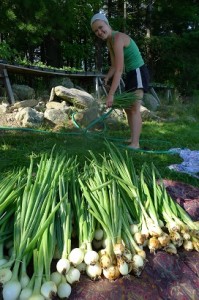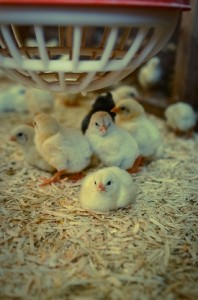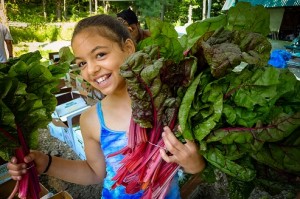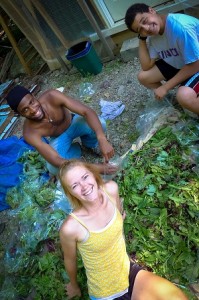- collard greens (1 bunch)
- red chard (1 bunch)
- green cabbage (1-2 heads)
- carrots (1 big bunch)
- brasing greens or turnips (1 bunch)
- lettuce (2-3 heads)
- salad mix (3/4 pound) – wash thoroughly
- sweet basil, lemon basil, thai basil (1 bunch)
- green onions (1 bunch)
- curly parsley (1 bunch)
- dozen eggs or sprout mix (brown lentil, mung bean, french lentil, zesty mustard mix)
- Please RETURN YOUR BOXES, JARS, BAGS and clean egg cartons. You can leave them where you get your share and we will retrieve them each week. Try not to rip the boxes when breaking them down. Better to keep them assembled.
- WASHING YOUR VEGGIES. We do not extensively wash veggies before delivering them to you. We will do some washing if there is a lot of dirt on greens and we always wash root crops. In general, this allows the food to stay fresher longer. It also means you need to wash your veggies before consuming them. For greens: fill a bowl with cold water. Soak greens in water for a minute. Drain water and repeat two more times. Dirt will rinse to the bottom. Bugs should float to the top.
- WE HAVE A ROAD SIGN. Look for it when you are coming to visit.
- We are looking for a delivery van. If you have any leads on something efficient, in decent shape, and affordable, please let us know!
- If you are a shareholder, you have the option of volunteering 5 hours over the course of the season in exchange for an additional week of food in the fall. Be in touch to schedule your work with us.
- Pasture raised poultry for mid summer and fall is available for pre-sale here.
- Remember that you are always welcome to visit socially and/or to volunteer. Give a call to schedule a time.
- All of our newsletters are archived on our website, along with lots more, including educational resources and recipes.

- Like us on Facebook. There are larger picture albums there, and more being added each week.
Food Justice News – DEFINITION OF FOOD SOVEREIGNTY (FROM THE DECLARATION OF NYÉLÉNI)
Food sovereignty is the right of peoples to healthy and culturally appropriate food produced through ecologically sound and sustainable methods, and their right to define their own food and agriculture systems. It puts the aspirations and needs of those who produce, distribute and consume food at the heart of food systems and policies rather than the demands of markets and corporations. It defends the interests and inclusion of the next generation. It offers a strategy to resist and dismantle the current corporate trade and food regime, and directions for food, farming, pastoral and fisheries systems determined by local producers and users. Food sovereignty prioritises local and national economies and markets and empowers peasant and family farmer-driven agriculture, artisanal – fishing, pastoralist-led grazing, and food production, distribution and consumption based on environmental, social and economic sustainability. Food sovereignty promotes transparent trade that guarantees just incomes to all peoples as well as the rights of consumers to control their food and nutrition. It ensures that the rights to use and manage lands, territories, waters, seeds, livestock and biodiversity are in the hands of those of us who produce food. Food sovereignty implies new social relations free of oppression and inequality between men and women, peoples, racial groups, social and economic classes and generations.
SIX PRINCIPLES OF FOOD SOVEREIGNTY
- Focuses on Food for People: Food sovereignty puts the right to sufficient, healthy and culturally appropriate food for all individuals, peoples and communities, including those who are hungry, under occupation, in conflict zones and marginalised, at the centre of food, agriculture, livestock and fisheries policies; and rejects the proposition that food is just another commodity or component for international agri-business
- Values Food Providers: Food sovereignty values and supports the contributions, and respects the rights, of women and men, peasants and small scale family farmers, pastoralists, artisanal fisherfolk, forest dwellers, indigenous peoples and agricultural and fisheries workers, including migrants, who cultivate, grow, harvest and process food; and rejects those policies, actions and programmes that undervalue them, threaten their livelihoods and eliminate them.
- Localises Food Systems: Food sovereignty brings food providers and consumers closer together; puts providers and consumers at the centre of decision-making on food issues; protects food providers from the dumping of food and food aid in local markets; protects consumers from poor quality and unhealthy food, inappropriate food aid and food tainted with genetically modified organisms; and rejects governance structures, agreements and practices that depend on and promote unsustainable and inequitable international trade and give power to remote and unaccountable corporations.

- Puts Control Locally: Food sovereignty places control over territory, land, grazing, water, seeds, livestock and fish populations on local food providers and respects their rights. They can use and share them in socially and environmentally sustainable ways which conserve diversity; it recognizes that local territories often cross geopolitical borders and ensures the right of local communities to inhabit and use their territories; it promotes positive interaction between food providers in different regions and territories and from different sectors that helps resolve internal conflicts or conflicts with local and national authorities; and rejects the privatisation of natural resources through laws, commercial contracts and intellectual property rights regimes.
- Builds Knowledge and Skills: Food sovereignty builds on the skills and local knowledge of food providers and their local organisations that conserve, develop and manage localised food production and harvesting systems, developing appropriate research systems to support this and passing on this wisdom to future generations; and rejects technologies that undermine, threaten or contaminate these, e.g. genetic engineering.
- Works with Nature: Food sovereignty uses the contributions of nature in diverse, low external input agroecological production and harvesting methods that maximise the contribution of ecosystems and improve resilience and adaptation, especially in the face of climate change; it seeks to “heal the planet so that the planet may heal us”; and rejects methods that harm beneficial ecosystem functions, that depend on energy intensive monocultures and livestock factories, destructive fishing practices and other industrialised production methods, which damage the environment and contribute to global warming.
These six principles are interlinked and inseparable: in implementing the food sovereignty policy framework all should be applied.
Recipe – Sauerkraut
Traditional sauerkraut is not made with vinegar, but rather allowed to age in its own brine for several days and then stored for months to cure it. This process is the only food preservation method that actually increases the nutritional quality of food. The process, called fermentation (nothing to do with lactose in milk), results in some of the most delicious and health giving foods. Lactofermented foods are rich with the same bacteria that are found in our digestive system and are responsible for effectively digesting our food so we can absorb and access all the nutrients food has to offer. If you have ever taken probiotics, you may have heard of the most popular one, Lactobacillis acidolphilus. That is where the “lacto” comes from in the term lactofermentation.
Here is our basic sauerkraut recipe, but the same process can be used with almost any low-sugar vegetables, and with the additional of spices and herbs.
Ingredients
- 2 lbs fresh cabbage
- 2 tsp sea salt (or non-iodized)
Directions
Lightly wash cabbage. DO NOT SCRUB the cabbage, as the existing enzymes and bacteria on the surface of the cabbage are essential to start the fermentation process. Thinly slice cabbage and put in large container. Add 1 teaspoon sea salt per pound of cabbage and massage into the cabbage. This breaks the cell walls of the cabbage to allow the salt to draw out the water. Let sit for 20 minutes of more. You will notice a layer the container filling with brine and the cabbage “shrinking” in size. Stuff the cabbage tightly into glass jars, using a spoon if necessary to reach the bottom of the container. Leave approximately an inch of space above the cabbage, and make sure it is completely covered with brine. If the existing brine in the jar is not enough to cover, add additional brine from your original container. Lightly screw on lid, allowing air to escape. DO NOT SEAL as pressure will build up. Set out in a room temperature, out of the sun for 3-5 days. The fermentation process creates enough gases that the brine will start bubbling over and out of the jars, so place a cookies tray or bowl under the jars. After 4 days or so, the fermentation process has gone through 4 stages of bacterial and enzymatic growth, culminating in the acidophilus stage, at which point it can be eaten, or left to age. Cooling the kraut will slow the process down to a minimum. This can be done in your refrigerator, cool basement, root cellar if you have one, or burying it in the ground. For real! It is okay to try it at various times and continue to let it age. We prefer ours after several months. Also try other vegetables, chilies, caraway, garlic, ginger, whatever you can dream up.
 Recipe – Herb Pesto
Recipe – Herb Pesto
- 1 cup packed fresh basil leaves
- 1 cup packed fresh parsley leaves
- 4 cloves garlic
- 1/4 cup nuts or seeds (sunflower, almond, walnut, etc)
- 2/3 cup extra-virgin olive oil
- Kosher salt and freshly ground black pepper, to taste
Directions
Combine the herbs, garlic, and nuts in a food processor and pulse until coarsely chopped. Add 1/2 cup of the oil and process until fully incorporated and smooth. Season with salt and pepper. If using immediately, add all the remaining oil and pulse until smooth. Transfer the pesto to a large serving bowl. If freezing, transfer to an air-tight container and drizzle remaining oil over the top. Freeze for up to 3 months.
Farm News
Your shares this week look like we love them to look. So full, we can barely close the boxes. So colorful, we can’t help taking pictures. So delicious smelling we can’t help pausing to close our eyes and take a deep breath of fresh herb and veggie smell. This week we welcomed Jordan Taylor of Albany to the crew. He will be joining us two and a half days a week for the summer and then full-time later in the season. Jordan brings his giant smile and positive outlook on life. We also welcomed the last of the chickens to the farm this season. Fifty chicks arrived Tuesday that be the final meat birds of the season. This means that the 100 plus baby laying hens went out to pasture for the first time. It is a joy to watch them get their first taste of bugs, grass, sunlight, and run around freely. We expect these birds to start laying eggs in October and November, just in time for winter egg shares. And we say a temporary goodbye to our most delightful helper, Elie Lev. Elie has been coming to help a few days each week for the past several weeks. Elie is 13 and a wonderful spirit to be around. He has challenged himself, being the youngest part of our crew and joining us for this very physically demanding work. We will miss his constant commentary and banter that is irresistibly hilarious.
Here on the farm we continue to chase the weeds around, but also watch our plantings shoot up each time we turn around. Tomatoes are forming on their vines. Beans are fattening up. Potatoes, winter squash, garlic, broccoli, even the sweet potatoes that we once thought completely dead are going bananas! Look for these and more items in the coming months. And finally, we were approved for a grant from the USDA to build a large high tunnel which we plan to use for winter crops, as well as all of our hot crops, such as tomatoes, peppers, squash, melons, we may even try ginger on a bigger scale.
Enjoy your food this week. I spared you more radicchio, as I pictured most of it probably still sitting untouched in your fridge. It wont hurt my feelings if you compost it.


